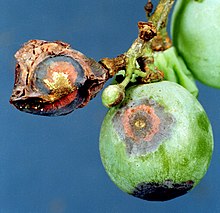




The 2020 table grape harvest was worth $2.12 billion[1] while wine grapes brought in $1.7 billion, down 15.3% year-on-year. By weight this was 17% lower versus 2018.[2] The next year, 2021[3] saw a much better yield. From 829,000 acres (335,000 ha) viniculturists got 6.94 short tons per acre (15.6 t/ha) for a total harvest of 5,755,000 short tons (5,221,000 t).[3] At an average of $909 per short ton ($1,002/t) they were paid $5,229,902,000 for the season.[3] Of that, 4,844,600 short tons (4,394,900 t) were for destined for processing industries (including wine, see § Wine below) and at $835 per short ton ($920/t) that was worth $4,046,382,000.[3] The fresh (table grape) harvest was 910,400 short tons (825,900 t) and selling at a price of $1,300 per short ton ($1,433/t), this sector was worth $1,183,520,000 for the season.[3]
The table grape and wine grape sectors are represented by the Table Grape Commission[4] and the California Association of Winegrape Growers.[5]
Table production is most concentrated in three counties and somewhat in another two.[6] Dollar value annually is $1,240 million in Kern, $682 in Tulare, $416 in Fresno, and in the top ten crops in Riverside and Madera.[6] California's own consumption of table production grew from 1980 to 2001 from 1.8 to 3.5 kilograms (4.0 to 7.7 lb) per capita per year.[7] Consumption here and throughout the country is so high that the country remains a net importer despite this state's production, which reached 71,000 short tons (64,000 t) in the 2015 table harvest.[7]
During dormancy, UC IPM recommends pruning.[8] UC IPM publishes recommendations for this and other tasks during dormancy.[8] Although thinning is often proven to improve wine qualities in many areas, some reviewers note a lack of benefit in thinning table grapes in this state's vineyards.[9]
Deyett et al., 2020 finds Proteobacteria are the most common components of the microbiomes of this crop in this state's soils.[10]
This crop has also played a large part in farm labor relations in the state.[11]: 371 The Delano grape strike began among table grape workers before spreading to other industries.[11]: 371 See § Labor.


- ^ "All About Grapes". Grapes from California. June 17, 2021. Retrieved April 23, 2022.
- ^ Moller, William J. (July 1, 1980). "Milestones in grape pathology". California Agriculture. 34 (7). UC Agriculture and Natural Resources: 13–15. doi:10.3733/ca.v034n07p13 (inactive 1 November 2024). ISSN 0073-2230. S2CID 82168201.
{{cite journal}}: CS1 maint: DOI inactive as of November 2024 (link) - ^ a b c d e "USDA/NASS 2021 State Agriculture Overview for California". USDA. Retrieved June 11, 2022.
- ^ "Home". Grapes from California. May 16, 2022. Retrieved June 16, 2022.
- ^ "Home". California Association of Winegrape Growers. Archived from the original on June 24, 2019. Retrieved June 16, 2022.
- ^ a b Goodhue, Rachaelg; Gress, Brian; Zheng, Yanan; Raburn, Sam; Spaldin, Ashley; Mace, Kevi (2021). An Economic and Pest Management Evaluation of the Insecticide Imidacloprid in California Agriculture (Report). California Department of Pesticide Regulation. pp. 1–65.
- ^ a b Daane, Kent; Vincent, Charles; Isaacs, Rufus; Ioriatti, Claudio (2018). "Entomological Opportunities and Challenges for Sustainable Viticulture in a Global Market". Annual Review of Entomology. 63 (1). Annual Reviews: 193–214. doi:10.1146/annurev-ento-010715-023547. ISSN 0066-4170. PMID 29324036.
- ^ a b "Dormancy / Grape / Agriculture: Pest Management". University of California Integrated Pest Management. University of California Agriculture and Natural Resources. 2015. 3448. Retrieved November 22, 2022.
- ^ Di Lorenzo, R.; Gambino, C.; Scafidi, P. (2011). "Summer pruning in table grape". Advances in Horticultural Science. 25 (3). Firenze University Press: 143–150. JSTOR 42882831.
- ^ Cobos, Rebeca; Ibanez, Ana; Diez, Alba; Pena, Carla; Ghoreshizadeh, Seyedehtannaz; Coque, Juan (2022). "The Grapevine Microbiome to the Rescue: Implications for the Biocontrol of Trunk Diseases". Plants. 11 (7). MDPI: 840. doi:10.3390/plants11070840. PMC 9003034. PMID 35406820.
- ^ a b Cornford, D. (2022). Working People of California. UC Press Voices Revived. University of California Press. p. 504. ISBN 9780520332768.
